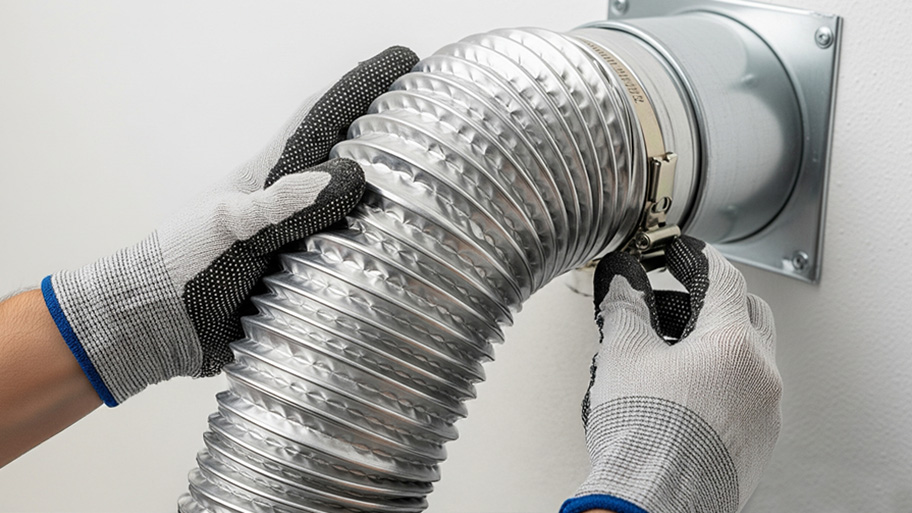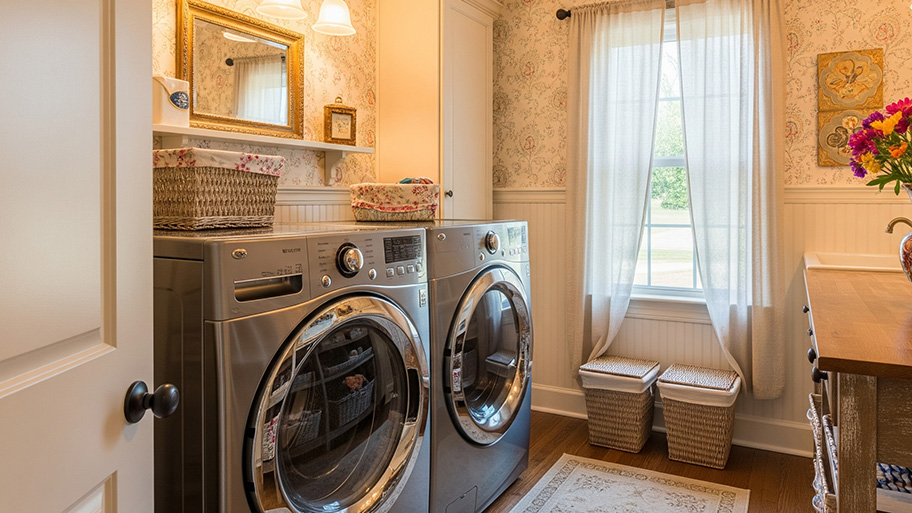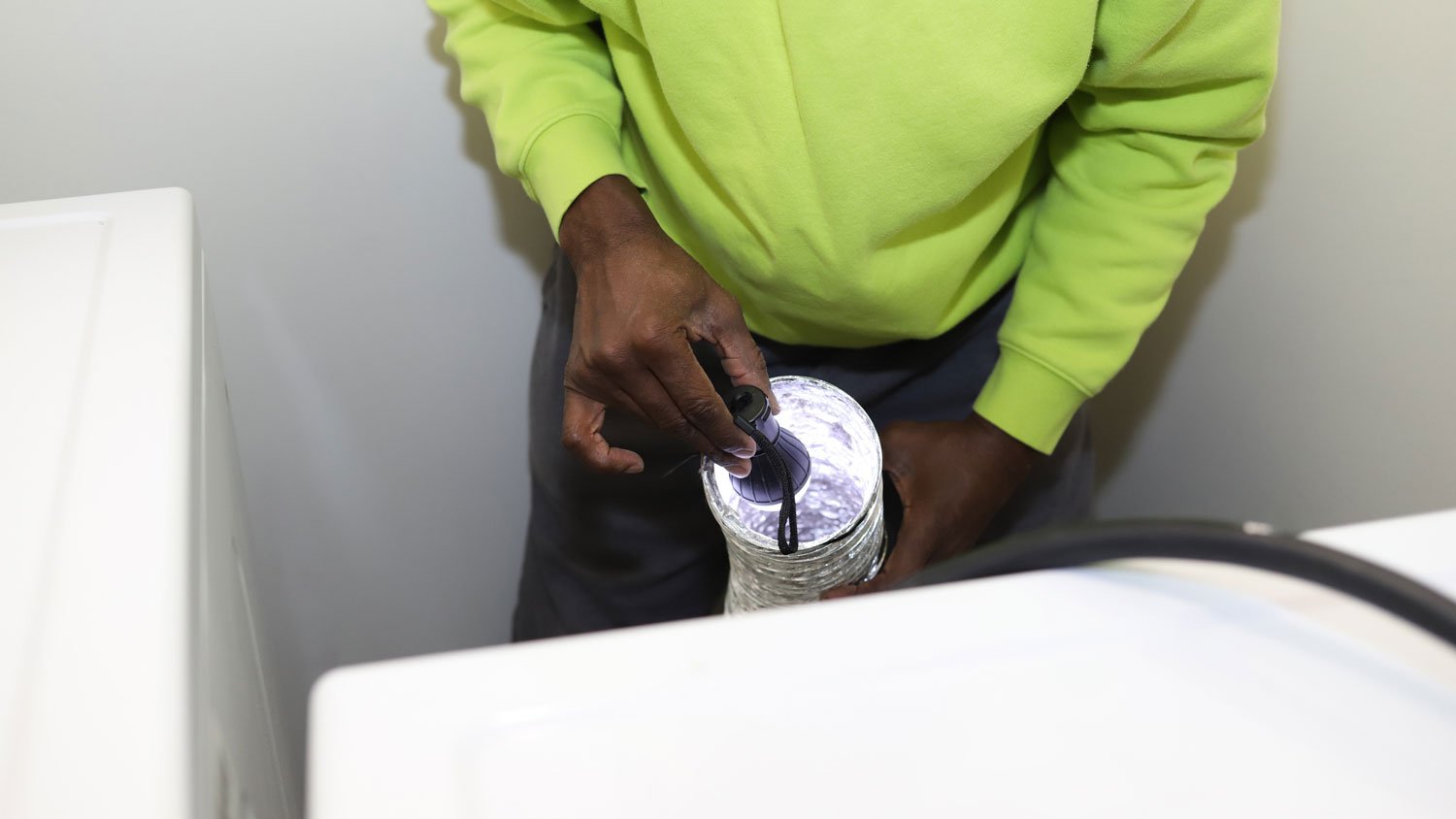
A dryer vent cleaning cost averages about $140 when done by a professional. Read our tips to understand the key cost factors involved in dryer vent cleaning.
A good vent is the key to avoiding re-running the dryer cycle to get clothes dry


Having the right dryer vent helps your clothes dry faster.
It also ensures safety in your home by preventing fire risk.
The right type of vent varies by dryer placement.
A dryer vent is a duct or passage that connects a clothes dryer to the outside, allowing hot air, moisture, and lint to be safely expelled from the dryer and home during the drying process. It plays a crucial role in maintaining proper airflow, preventing overheating, and reducing the risk of fire hazards. Depending on where your dryer is in your home and the layout of the room, certain dryer vent types may be a better fit for you. If you’re unsure of which dryer vent type is right, you can always work with a professional dryer repair specialist near you.
Keep reading for insight into 14 different dryer venting options.
A popular and widely-used choice, the wall-mounted exterior venting option efficiently directs the exhaust from your dryer through an exterior wall. Proper placement is key to maintaining unobstructed airflow and preventing potential hazards caused by blockages, ensuring both safety and optimal drying performance. This method not only promotes energy efficiency but also safeguards the integrity of your home's structure.
For those seeking an alternative, the roof-mounted exterior venting style allows the dryer exhaust to ascend and exit through the roof. Meticulous installation is paramount, as it prevents leaks and guarantees the effectiveness of ventilation, which is crucial for maintaining safety and preserving the overall integrity of your residence. This method of venting requires careful consideration of roofing materials and weatherproofing techniques.
Ideal for basements or homes where wall or roof mounting is impractical or impossible, the ground-level exterior venting option channels the dryer exhaust through an opening at ground level. This approach offers a versatile solution while upholding efficient airflow management. Whether your laundry space is located in a basement or a confined area, this choice maintains the effectiveness of your dryer's performance.
When outdoor venting is unfeasible, the indoor lint trap emerges as a practical solution. Installed within your living space, this device captures lint and moisture from the dryer exhaust, preventing them from accumulating indoors. Regular cleaning is essential to avert air quality deterioration and mitigate the potential fire hazards associated with trapped lint. By choosing this option, you prioritize both safety and air quality.
In situations where outdoor venting is not an available option, the vent bucket serves as an efficient indoor solution. It collects lint and moisture, ensuring they do not disperse throughout your living area. It is particularly convenient for apartments or temporary setups. However, regular maintenance, including emptying the bucket, is critical to maintaining the efficiency of the drying process and eliminating potential safety risks.
Designed to address the limitations of not having outdoor access for dryer venting, the vent box offers a practical indoor alternative by creating an enclosed environment. This innovative solution not only houses the dryer but also filters and manages the exhaust air, providing a controlled indoor venting system. However, it's crucial to emphasize the necessity of ongoing maintenance to ensure proper ventilation. Regular upkeep is imperative to prevent the buildup of moisture within the enclosed space, mitigating the potential risks of mold growth and safeguarding the quality of indoor air. By using the vent box, you strike a balance between convenience and indoor air quality, fostering a more comfortable and hygienic living environment.

When dealing with limited space, the periscope vent offers an ingenious solution. This adjustable duct permits dryers to be positioned closer to walls in tight areas. This not only optimizes space but also maintains proper airflow, which is crucial for effective venting. By using this option, you address space constraints without compromising on drying efficiency.
Designed to facilitate venting through walls, the through-the-wall venting kit consists of a wall plate and telescoping vent. This option is particularly useful for homes lacking pre-existing venting infrastructure. Correct installation guarantees both efficiency and adherence to safety codes, ensuring that your dryer operates optimally without jeopardizing your home's structure.
This specialized kit directs dryer exhaust through the roof while maintaining weather-tight seals. The careful installation of this kit is imperative to prevent leaks and ensure optimal ventilation. By opting for this solution, you safeguard your home from potential hazards and weather-related concerns, ensuring the long-term integrity of your roofing system.
Crafted from materials known for their pliability, flexible ducts present an installation-friendly option, particularly for straightforward setups. Their malleability simplifies the installation process, yet it's important to acknowledge their susceptibility to lint accumulation and kinks that can impede the flow of air. While these ducts serve well in uncomplicated configurations, consistent vigilance through regular dryer vent inspections and maintenance becomes imperative to uphold their intended efficiency. This proactive approach not only ensures optimal performance but also acts as a preventive measure against potential fire hazards stemming from reduced airflow. By choosing flexible ducts, you engage in a balance between convenience and safety, and your commitment to regular maintenance contributes to prolonged effectiveness and safer dryer operations.
Balancing durability and improved airflow, semi-rigid metal ducts are less prone to lint accumulation and kinks. This makes them suitable for medium-length dryer vent runs. Adhering to installation guidelines is essential to ensure both efficiency and safety, thus optimizing the performance of your dryer.
Engineered with a focus on durability and efficiency, rigid metal ducts stand as a robust solution crafted specifically to accommodate longer vent runs. The inherent sturdiness of these ducts ensures structural integrity even over extended distances, facilitating a seamless and unimpeded flow of air and exhaust. The key to their effectiveness lies in the combination of careful planning and precise installation, as a well-thought-out route with minimal bends guarantees efficient airflow, reducing the risk of lint buildup and potential fire hazards. By choosing rigid metal ducts, you make a deliberate choice to prioritize safety alongside optimized drying performance for your home, creating a durable and efficient venting solution that stands as a testament to responsible homeowner practices.
Installed to enhance airflow in longer or more complex vent installations, booster fans mitigate the risk of lint accumulation and bolster drying efficiency. Regular maintenance is crucial to ensure the proper operation of the fan and the continued effectiveness of the venting system. By using a booster fan, you optimize the overall performance of your dryer while minimizing potential issues.
From average costs to expert advice, get all the answers you need to get your job done.

A dryer vent cleaning cost averages about $140 when done by a professional. Read our tips to understand the key cost factors involved in dryer vent cleaning.

If you need to move your dryer, or you’re buying a home without proper ductwork, you’ll want to make sure the right pro installs your dryer vent. Read on to find out who installs dryer vents to get the job done quickly and easily.

Don’t let a dirty dryer vent cause problems in your home. Not sure how often to clean a dryer vent? Keep reading to learn best practices.

Knowing what questions to ask a dryer cleaning pro can help prepare you for the job. Check out these dryer vent questions before cleaning your dryer vents.

Are you concerned that your dryer vent has accumulated too much lint and debris? Learn who cleans dryer vents so you can hire the best professional for the job.

Shortening your dryer vent saves energy costs, could extend the life of your clothes dryer, and is an excellent project for beginning DIYers.